Mohammad Rostami
TNG-CLIP:Training-Time Negation Data Generation for Negation Awareness of CLIP
May 24, 2025Abstract:Vision-language models (VLMs), such as CLIP, have demonstrated strong performance across a range of downstream tasks. However, CLIP is still limited in negation understanding: the ability to recognize the absence or exclusion of a concept. Existing methods address the problem by using a large language model (LLM) to generate large-scale data of image captions containing negation for further fine-tuning CLIP. However, these methods are both time- and compute-intensive, and their evaluations are typically restricted to image-text matching tasks. To expand the horizon, we (1) introduce a training-time negation data generation pipeline such that negation captions are generated during the training stage, which only increases 2.5% extra training time, and (2) we propose the first benchmark, Neg-TtoI, for evaluating text-to-image generation models on prompts containing negation, assessing model's ability to produce semantically accurate images. We show that our proposed method, TNG-CLIP, achieves SOTA performance on diverse negation benchmarks of image-to-text matching, text-to-image retrieval, and image generation.
Multi-modal Synthetic Data Training and Model Collapse: Insights from VLMs and Diffusion Models
May 10, 2025Abstract:Recent research has highlighted the risk of generative model collapse, where performance progressively degrades when continually trained on self-generated data. However, existing exploration on model collapse is limited to single, unimodal models, limiting our understanding in more realistic scenarios, such as diverse multi-modal AI agents interacting autonomously through synthetic data and continually evolving. We expand the synthetic data training and model collapse study to multi-modal vision-language generative systems, such as vision-language models (VLMs) and text-to-image diffusion models, as well as recursive generate-train loops with multiple models. We find that model collapse, previously observed in single-modality generative models, exhibits distinct characteristics in the multi-modal context, such as improved vision-language alignment and increased variance in VLM image-captioning task. Additionally, we find that general approaches such as increased decoding budgets, greater model diversity, and relabeling with frozen models can effectively mitigate model collapse. Our findings provide initial insights and practical guidelines for reducing the risk of model collapse in self-improving multi-agent AI systems and curating robust multi-modal synthetic datasets.
Plug-and-Play AMC: Context Is King in Training-Free, Open-Set Modulation with LLMs
May 06, 2025Abstract:Automatic Modulation Classification (AMC) is critical for efficient spectrum management and robust wireless communications. However, AMC remains challenging due to the complex interplay of signal interference and noise. In this work, we propose an innovative framework that integrates traditional signal processing techniques with Large-Language Models (LLMs) to address AMC. Our approach leverages higher-order statistics and cumulant estimation to convert quantitative signal features into structured natural language prompts. By incorporating exemplar contexts into these prompts, our method exploits the LLM's inherent familiarity with classical signal processing, enabling effective one-shot classification without additional training or preprocessing (e.g., denoising). Experimental evaluations on synthetically generated datasets, spanning both noiseless and noisy conditions, demonstrate that our framework achieves competitive performance across diverse modulation schemes and Signal-to-Noise Ratios (SNRs). Moreover, our approach paves the way for robust foundation models in wireless communications across varying channel conditions, significantly reducing the expense associated with developing channel-specific models. This work lays the foundation for scalable, interpretable, and versatile signal classification systems in next-generation wireless networks. The source code is available at https://github.com/RU-SIT/context-is-king
Hybrid Learners Do Not Forget: A Brain-Inspired Neuro-Symbolic Approach to Continual Learning
Mar 16, 2025Abstract:Continual learning is crucial for creating AI agents that can learn and improve themselves autonomously. A primary challenge in continual learning is to learn new tasks without losing previously learned knowledge. Current continual learning methods primarily focus on enabling a neural network with mechanisms that mitigate forgetting effects. Inspired by the two distinct systems in the human brain, System 1 and System 2, we propose a Neuro-Symbolic Brain-Inspired Continual Learning (NeSyBiCL) framework that incorporates two subsystems to solve continual learning: A neural network model responsible for quickly adapting to the most recent task, together with a symbolic reasoner responsible for retaining previously acquired knowledge from previous tasks. Moreover, we design an integration mechanism between these components to facilitate knowledge transfer from the symbolic reasoner to the neural network. We also introduce two compositional continual learning benchmarks and demonstrate that NeSyBiCL is effective and leads to superior performance compared to continual learning methods that merely rely on neural architectures to address forgetting.
DenoMAE2.0: Improving Denoising Masked Autoencoders by Classifying Local Patches
Feb 25, 2025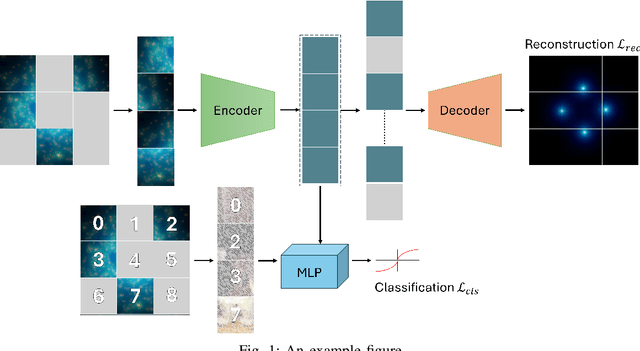
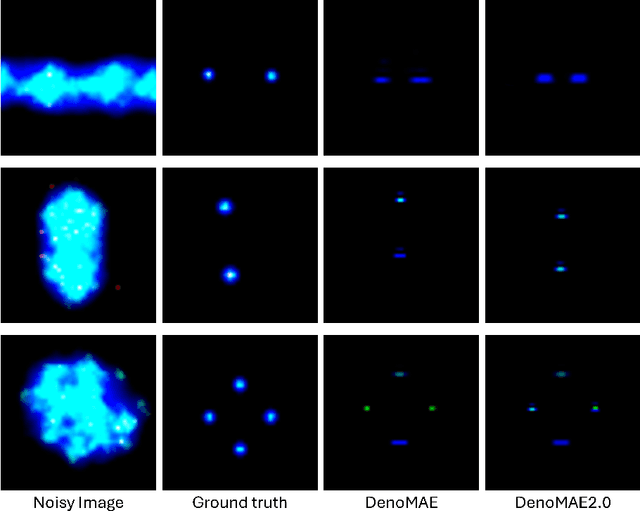

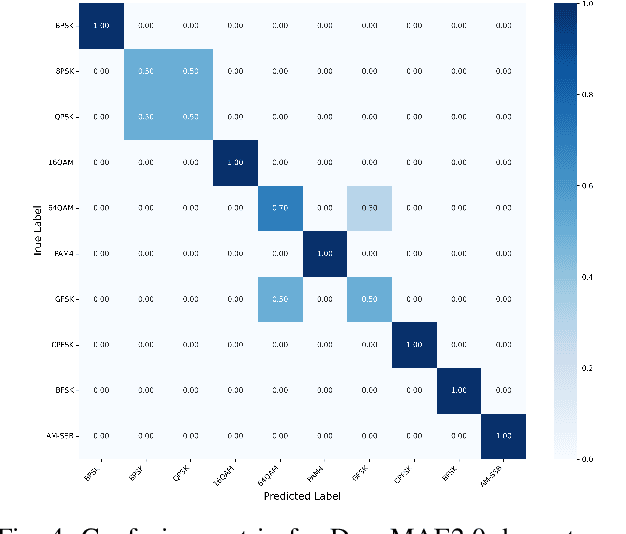
Abstract:We introduce DenoMAE2.0, an enhanced denoising masked autoencoder that integrates a local patch classification objective alongside traditional reconstruction loss to improve representation learning and robustness. Unlike conventional Masked Autoencoders (MAE), which focus solely on reconstructing missing inputs, DenoMAE2.0 introduces position-aware classification of unmasked patches, enabling the model to capture fine-grained local features while maintaining global coherence. This dual-objective approach is particularly beneficial in semi-supervised learning for wireless communication, where high noise levels and data scarcity pose significant challenges. We conduct extensive experiments on modulation signal classification across a wide range of signal-to-noise ratios (SNRs), from extremely low to moderately high conditions and in a low data regime. Our results demonstrate that DenoMAE2.0 surpasses its predecessor, Deno-MAE, and other baselines in both denoising quality and downstream classification accuracy. DenoMAE2.0 achieves a 1.1% improvement over DenoMAE on our dataset and 11.83%, 16.55% significant improved accuracy gains on the RadioML benchmark, over DenoMAE, for constellation diagram classification of modulation signals.
Cross-domain Few-shot Object Detection with Multi-modal Textual Enrichment
Feb 23, 2025Abstract:Advancements in cross-modal feature extraction and integration have significantly enhanced performance in few-shot learning tasks. However, current multi-modal object detection (MM-OD) methods often experience notable performance degradation when encountering substantial domain shifts. We propose that incorporating rich textual information can enable the model to establish a more robust knowledge relationship between visual instances and their corresponding language descriptions, thereby mitigating the challenges of domain shift. Specifically, we focus on the problem of Cross-Domain Multi-Modal Few-Shot Object Detection (CDMM-FSOD) and introduce a meta-learning-based framework designed to leverage rich textual semantics as an auxiliary modality to achieve effective domain adaptation. Our new architecture incorporates two key components: (i) A multi-modal feature aggregation module, which aligns visual and linguistic feature embeddings to ensure cohesive integration across modalities. (ii) A rich text semantic rectification module, which employs bidirectional text feature generation to refine multi-modal feature alignment, thereby enhancing understanding of language and its application in object detection. We evaluate the proposed method on common cross-domain object detection benchmarks and demonstrate that it significantly surpasses existing few-shot object detection approaches.
DenoMAE: A Multimodal Autoencoder for Denoising Modulation Signals
Jan 20, 2025Abstract:We propose Denoising Masked Autoencoder (Deno-MAE), a novel multimodal autoencoder framework for denoising modulation signals during pretraining. DenoMAE extends the concept of masked autoencoders by incorporating multiple input modalities, including noise as an explicit modality, to enhance cross-modal learning and improve denoising performance. The network is pre-trained using unlabeled noisy modulation signals and constellation diagrams, effectively learning to reconstruct their equivalent noiseless signals and diagrams. Deno-MAE achieves state-of-the-art accuracy in automatic modulation classification tasks with significantly fewer training samples, demonstrating a 10% reduction in unlabeled pretraining data and a 3% reduction in labeled fine-tuning data compared to existing approaches. Moreover, our model exhibits robust performance across varying signal-to-noise ratios (SNRs) and supports extrapolation on unseen lower SNRs. The results indicate that DenoMAE is an efficient, flexible, and data-efficient solution for denoising and classifying modulation signals in challenging noise-intensive environments.
pMixFed: Efficient Personalized Federated Learning through Adaptive Layer-Wise Mixup
Jan 19, 2025



Abstract:Traditional Federated Learning (FL) methods encounter significant challenges when dealing with heterogeneous data and providing personalized solutions for non-IID scenarios. Personalized Federated Learning (PFL) approaches aim to address these issues by balancing generalization and personalization, often through parameter decoupling or partial models that freeze some neural network layers for personalization while aggregating other layers globally. However, existing methods still face challenges of global-local model discrepancy, client drift, and catastrophic forgetting, which degrade model accuracy. To overcome these limitations, we propose pMixFed, a dynamic, layer-wise PFL approach that integrates mixup between shared global and personalized local models. Our method introduces an adaptive strategy for partitioning between personalized and shared layers, a gradual transition of personalization degree to enhance local client adaptation, improved generalization across clients, and a novel aggregation mechanism to mitigate catastrophic forgetting. Extensive experiments demonstrate that pMixFed outperforms state-of-the-art PFL methods, showing faster model training, increased robustness, and improved handling of data heterogeneity under different heterogeneous settings.
Static Key Attention in Vision
Dec 09, 2024



Abstract:The success of vision transformers is widely attributed to the expressive power of their dynamically parameterized multi-head self-attention mechanism. We examine the impact of substituting the dynamic parameterized key with a static key within the standard attention mechanism in Vision Transformers. Our findings reveal that static key attention mechanisms can match or even exceed the performance of standard self-attention. Integrating static key attention modules into a Metaformer backbone, we find that it serves as a better intermediate stage in hierarchical hybrid architectures, balancing the strengths of depth-wise convolution and self-attention. Experiments on several vision tasks underscore the effectiveness of the static key mechanism, indicating that the typical two-step dynamic parameterization in attention can be streamlined to a single step without impacting performance under certain circumstances.
NMformer: A Transformer for Noisy Modulation Classification in Wireless Communication
Oct 30, 2024
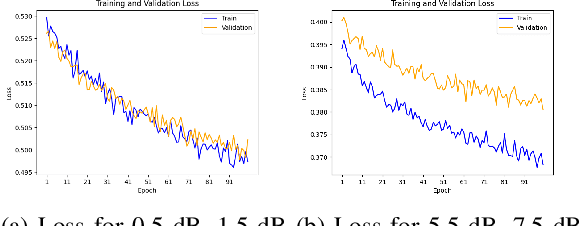

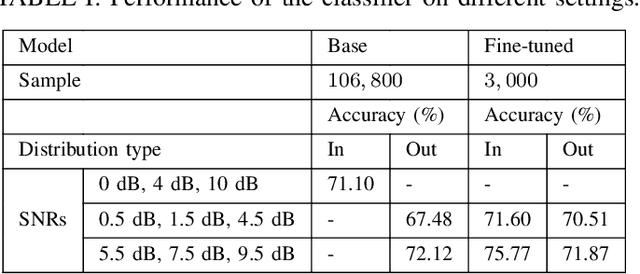
Abstract:Modulation classification is a very challenging task since the signals intertwine with various ambient noises. Methods are required that can classify them without adding extra steps like denoising, which introduces computational complexity. In this study, we propose a vision transformer (ViT) based model named NMformer to predict the channel modulation images with different noise levels in wireless communication. Since ViTs are most effective for RGB images, we generated constellation diagrams from the modulated signals. The diagrams provide the information from the signals in a 2-D representation form. We trained NMformer on 106, 800 modulation images to build the base classifier and only used 3, 000 images to fine-tune for specific tasks. Our proposed model has two different kinds of prediction setups: in-distribution and out-of-distribution. Our model achieves 4.67% higher accuracy than the base classifier when finetuned and tested on high signal-to-noise ratios (SNRs) in-distribution classes. Moreover, the fine-tuned low SNR task achieves a higher accuracy than the base classifier. The fine-tuned classifier becomes much more effective than the base classifier by achieving higher accuracy when predicted, even on unseen data from out-of-distribution classes. Extensive experiments show the effectiveness of NMformer for a wide range of SNRs.
 Add to Chrome
Add to Chrome Add to Firefox
Add to Firefox Add to Edge
Add to Edge